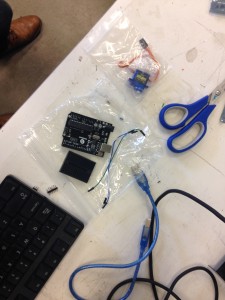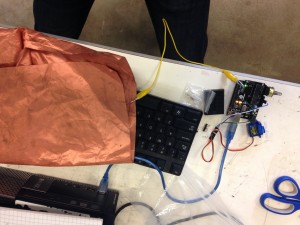This week was (unfortunately) our final class at the Champaign-Urbana Community Fab Lab, however it was also exciting because we completed our final rotation and have now worked with digital embroidery, laser cutting, and Arduino kits! The final rotation was my favorite because my group got to work with the Arduino kits and learn the basics of Arduino coding. Since our final project will be based off of an Arduino for the tuning function, Josh, Annie, and I listened very closely to the instructor so that we could begin working on the software of the “Tuna-lele.” We began the class by learning about the Arduino code writing program on the computers in the FabLab, and is also available for free download so that we may work on coding outside of the FabLab as well. 
The kit came with an Arduino (the black programming board in the center), a few resistors, a USB cable, an LED light, and a motor with wires to connect it to the board. Our instructor showed us the sample programs that are already written into the Arduino desktop program, one of these being the blink program used to control the LED light. Inside the code, the user is able to edit which port the command will be sent to so that they will know where to place the ends of the LED. The user can also edit the code to control how long the light will stay on or off, in this video below we created a flickering effect in the bulb by shortening the amount of time the bulb was off. arduino video
After this we learned about the touch sensor in the program and how the Arduino can actually print off numbers to show when it senses pressure through the CapacitiveTouch Library that we imported into the code. We were able to connect different surfaces to the Arduino through alligator clips and expand the surface area of the sensor. Below is the picture of the copper sheet I used to expand my Arduino’s touch sensor, and it ended up working perfectly! After playing around with a few more programs, Annie, Josh and I were able to ask questions about our project and how we can use the adaptable sensors to attach a microphone to the Arduino. There are many different parts that we would have to use and while we may not be able to have the sensor identify pitch by May, we believe that we can have the sensor identify noise and may modify our product so that it senses volume instead of pitch. I am very thankful that we got to work in the FabLab otherwise I would be very clueless around the software of most of these designs! 


John, really liked your reflection about working with Arduinos! I thought your idea with the touch sensors was really cool as well!